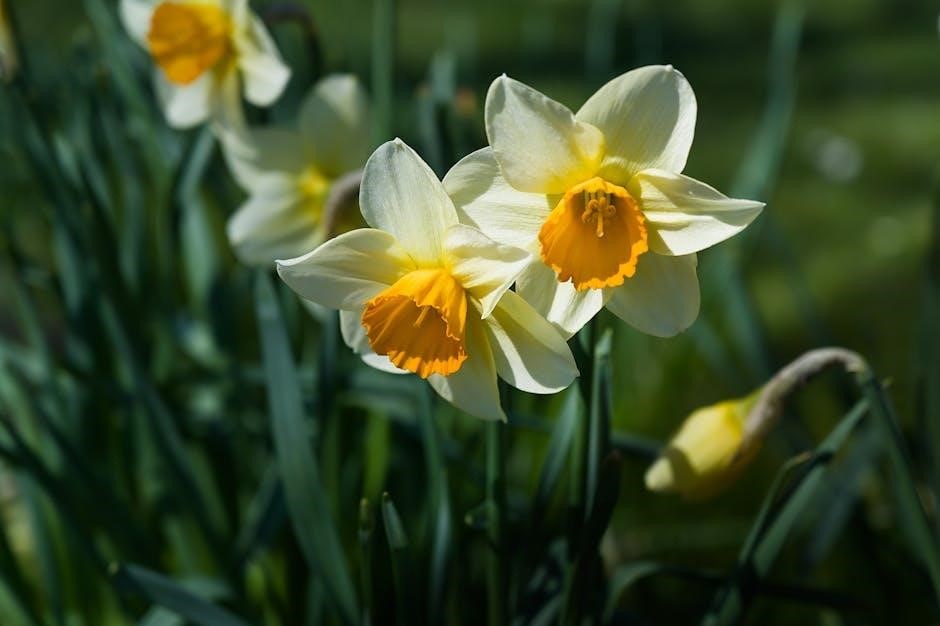
daffodils poem pdf
William Wordsworth’s “Daffodils” is a timeless masterpiece celebrating nature’s beauty and human emotion through vivid imagery and profound reflection, cherished for its enduring appeal.
1.1 Overview of the Poem
William Wordsworth’s “I Wandered Lonely as a Cloud,” often referred to as “Daffodils,” is one of his most celebrated works. Composed in 1804, the poem reflects the poet’s deep connection with nature. It describes a moment when the poet encounters a vibrant field of daffodils swaying in the breeze near Lake Ullswater. The poem is structured in four stanzas, each with a consistent rhyme scheme of ABABCC, creating a rhythmic and lyrical flow. The imagery of the dancing daffodils and the serene landscape evokes a sense of tranquility and joy. The poem also explores the idea of memory, as the poet reflects on the comfort and happiness the daffodils bring him in times of solitude. Central to the poem is the theme of nature’s ability to uplift the human spirit, making it a timeless and universal masterpiece.

1.2 Cultural Significance of the Poem
William Wordsworth’s “Daffodils” holds profound cultural significance as a cornerstone of Romantic literature. Its vivid depiction of nature resonates universally, symbolizing joy, hope, and renewal. The poem, part of Lyrical Ballads, marked a shift in poetry toward emotional and natural themes. It has inspired countless adaptations in art, music, and literature, becoming a cultural icon. The daffodil itself has become a symbol of resilience and beauty in many societies. The poem’s accessibility and timeless themes have made it a favorite in educational curricula and popular culture, ensuring its enduring legacy. Its ability to evoke emotion and connect humanity with nature continues to captivate readers, solidifying its place in cultural heritage.

The Poet: William Wordsworth
William Wordsworth, a major Romantic poet, is renowned for his focus on emotional depth and nature’s beauty. His works emphasize the connection between humanity and the natural world, influencing modern poetry profoundly.
2.1 Background and Biography
William Wordsworth was born on April 7, 1770, in Cumberland, England. His early life was shaped by the stunning landscapes of the Lake District, which deeply influenced his poetry. Wordsworth attended Cambridge University, where he developed a passion for literature and philosophy. His experiences during the French Revolution and his travels across Europe further shaped his views on nature, society, and human consciousness. In 1802, he married Mary Hutchinson, and the couple settled in Grasmere, where Wordsworth became a central figure in the Romantic movement. His poetry often reflects his belief in the healing power of nature and the importance of emotional and spiritual experiences.

2.worth’s Poetic Style
William Wordsworth’s poetic style is characterized by a deep connection to nature, simplicity, and the exploration of human emotion. He often used everyday language to make his poetry accessible while infusing it with profound philosophical insights. Wordsworth emphasized the beauty of the ordinary and the spiritual dimensions of natural landscapes. His poetry frequently employs lyrical and meditative tones, reflecting his belief in the restorative power of nature. Wordsworth also pioneered the use of the first person in poetry, creating intimate and personal narratives. His work is rich in imagery and symbolism, drawing readers into a world of reflection and emotional resonance. This unique style helped establish Wordsworth as a leading figure in the Romantic movement, leaving a lasting impact on English literature.
The Poem: Structure and Themes
“Daffodils” features a lyrical structure, exploring themes of nature, solitude, and the poet’s emotional journey. Its rhythm and rhyme enhance the vivid imagery, creating a reflective and meditative tone.
3.1 Summary of the Poem
The poem “Daffodils” by William Wordsworth describes a serene encounter with a field of daffodils swaying in the breeze beside a lake. The speaker, initially wandering alone, is captivated by the vibrant beauty of the flowers, which seem to dance with joy. The daffodils’ carefree abandon and the natural setting evoke a deep sense of tranquility and wonder. While the speaker doesn’t fully grasp the experience in the moment, the memory of the daffodils later brings comfort and happiness, especially during times of solitude or melancholy. The poem underscores the profound impact of nature on the human spirit, highlighting how fleeting moments of beauty can leave lasting impressions that nurture the soul.

3.2 Major Themes in “Daffodils”
The poem “Daffodils” explores several major themes, including the beauty and restorative power of nature, the importance of solitude, and the role of memory in emotional well-being. Nature is portrayed as a source of inspiration and joy, with the daffodils symbolizing vitality and hope. The theme of solitude is evident in the speaker’s lonely wandering, which is transformed by the encounter with the flowers, suggesting that solitude can foster creativity and introspection. Memory plays a central role, as the poet reflects on the enduring impact of the daffodils long after the moment has passed. The poem also highlights the emotional journey from loneliness to joy, emphasizing how nature’s beauty can uplift the spirit. These themes reflect Wordsworth’s romantic ideals, celebrating nature’s ability to inspire and nurture the human soul.
3.3 The Role of Nature in the Poem
Nature plays a pivotal role in “Daffodils,” serving as both a setting and a central theme. The poem portrays nature as a living, dynamic force that interacts with the human spirit. The daffodils, swaying in the breeze, symbolize vitality and beauty, while the tranquil landscape evokes a sense of peace. Wordsworth uses nature to evoke emotions, from the initial loneliness of the wanderer to the joy inspired by the flowers; Nature’s ability to uplift and inspire is a recurring motif, reflecting Wordsworth’s belief in its restorative power. The poem also highlights the interconnectedness of nature and human experience, suggesting that natural beauty can transcend fleeting sorrows and bring lasting solace. Through this, Wordsworth celebrates nature’s role in fostering emotional and spiritual renewal.

Analysis of the Poem

The poem masterfully explores themes of beauty, memory, and emotional renewal through its lyrical structure and vivid imagery, offering profound insights into the human experience and nature’s impact.
4.1 Poetic Devices Used
Wordsworth employs a range of poetic devices in “Daffodils,” enhancing its lyrical and emotional depth. Similes, such as comparing daffodils to a “crowd dancing,” create vivid imagery. Personification is central, as nature is anthropomorphized, with daffodils “dancing” and waves “at play.” The poem’s rhythm and rhyme contribute to its musical quality, while alliteration adds texture. Imagery dominates, painting scenes of natural beauty. Metaphors, like the daffodils as “golden hosts,” amplify their splendor. Wordsworth’s use of enjambment and caesura emphasizes emotional flow, reflecting inner contemplation. These devices collectively evoke a sense of wonder and tranquility, embedding the poem’s themes of nature’s rejuvenating power and human emotional response.
4.2 Symbolism in “Daffodils”
The poem is rich in symbolism, with the daffodils representing hope, renewal, and the enduring beauty of nature. Their vibrant yellow color and swaying motion symbolize joy and resilience. The daffodils also embody the idea of natural beauty as a source of inspiration and comfort, transcending human struggles. Wordsworth uses the flowers to symbolize the connection between the individual and the natural world, highlighting nature’s ability to uplift the human spirit. The memory of the daffodils serves as a symbol of solace, reminding the poet of nature’s tranquility during times of despair. This symbolism underscores the poem’s central theme of nature as a healer and a source of spiritual renewal.
4.3 Emotional Impact of the Poem
The poem evokes a profound emotional response through its vivid portrayal of nature and introspection. Wordsworth masterfully captures the tranquility of the natural world, evoking feelings of serenity and joy. The daffodils, with their vibrant beauty, symbolize hope and resilience, uplifting the reader’s spirit. The poet’s recollection of the flowers during a moment of despair highlights nature’s comforting power, creating a sense of solace. The poem’s emotional depth lies in its ability to connect the reader with universal feelings of isolation and the need for renewal. Its reflective tone resonates deeply, offering a timeless reminder of nature’s capacity to heal and inspire. This emotional resonance ensures the poem’s enduring appeal, making it a cherished work of literature.

Historical Context
Written in 1804, “Daffodils” reflects the Romantic Movement’s emphasis on nature, contrasting the Industrial Revolution’s rise and celebrating nature’s emotional appeal in a changing cultural world.
5.1 The Romantic Movement
The Romantic Movement, flourishing in the late 18th and early 19th centuries, emphasized emotion, nature, and individualism. It emerged as a response to the Enlightenment’s rationalism and the Industrial Revolution’s mechanization. Poets like Wordsworth, Coleridge, and Byron spearheaded this movement, seeking inspiration from the natural world and human experiences. The movement celebrated the sublime, the picturesque, and the power of nature to evoke profound emotions. Wordsworth’s “Daffodils” epitomizes Romantic ideals through its vivid portrayal of nature and the introspective exploration of personal feelings. The poem reflects the era’s shift toward valuing subjective experience and the restorative power of the natural world, resonating deeply with the Romantic ethos of finding beauty and meaning in simplicity and solitude.
5.2 The Influence of the Industrial Revolution
The Industrial Revolution profoundly shaped the cultural and poetic landscape of Wordsworth’s time, as urbanization and mechanization transformed society. This period marked a shift from rural to industrial life, leading to a sense of disconnection from nature. Wordsworth, deeply troubled by this trend, sought to counteract the dehumanizing effects of industrialization through his poetry. “Daffodils” reflects his longing for a simpler, more harmonious relationship with the natural world. The poem’s focus on solitude, nature, and introspection can be seen as a response to the chaos and alienation of industrial life. By celebrating the beauty of daffodils and the restorative power of nature, Wordsworth offered a poetic antidote to the moral and spiritual challenges of his era, emphasizing the importance of reconnecting with the environment and one’s inner self.
Themes and Symbols
The poem explores themes of solitude and natural beauty, with daffodils symbolizing hope and renewal. Wordsworth uses nature to reflect inner peace and emotional rejuvenation.

6.1 The Concept of Solitude

The poem embodies solitude as a source of comfort and inspiration, reflecting Wordsworth’s belief in the restorative power of nature. The lonely wanderer, surrounded by vast natural landscapes, finds solace in the daffodils’ vibrant beauty. This isolation is not melancholic but transformative, allowing the speaker to connect deeply with the environment. The daffodils, swaying in the breeze, symbolize the harmony between solitude and the natural world. Wordsworth portrays solitude as a state of mindfulness, where the individual can reflect, rejuvenate, and find inner peace. This theme resonates universally, highlighting the importance of moments of quiet contemplation in a bustling world. The poem thus celebrates solitude as a pathway to self-discovery and emotional renewal, intertwined with the enduring beauty of nature.
6.2 The Symbolism of Daffodils
The daffodils in Wordsworth’s poem symbolize beauty, hope, and renewal, embodying the vibrant and enduring spirit of nature. Their golden hue and swaying dance represent joy and vitality, while their annual bloom signifies the cyclical nature of life and the promise of new beginnings. The daffodils also serve as a metaphor for the resilience of the human spirit, flourishing even in challenging environments. Wordsworth uses them to highlight the profound impact of nature on human emotions, offering solace and inspiration. The flowers are not just a visual spectacle but a source of inner strength and happiness, transcending their physical form to become a symbol of enduring beauty and the uplifting power of the natural world.
Wordsworth’s “Daffodils” remains a timeless ode to nature’s beauty and its profound impact on the human spirit, leaving a lasting legacy in literary history forever.
7.1 The Lasting Legacy of the Poem
William Wordsworth’s Daffodils has left an indelible mark on literary history, captivating readers with its timeless themes of nature, solitude, and inner joy. Its vivid imagery and emotional depth continue to inspire poets, artists, and thinkers, making it a cornerstone of Romantic literature; The poem’s ability to evoke universal human experiences ensures its relevance across generations. It remains a staple in educational curricula, introducing students to the beauty of poetry and the power of nature. The enduring popularity of Daffodils is a testament to Wordsworth’s genius, as it transcends time and cultural boundaries, offering solace and reflection in an ever-changing world. Its legacy endures as a celebration of life’s simple yet profound moments.